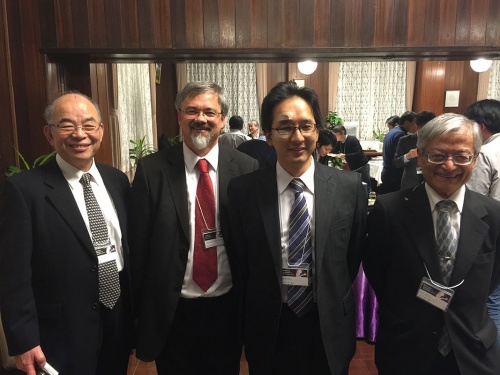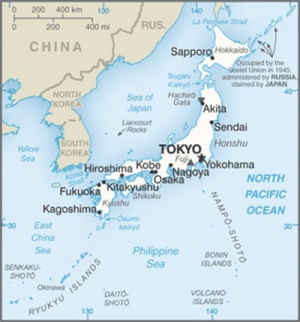Introduction
This page links to the current online resources available to explore Japanese population and birth data.
| Category:Japan
People
These are representative images of both historic and modern Japan people associated with embryological research and is not a comprehensive list.
Hideo Nishimura (1912–1995)
Kohei Shiota, Mark Hill, Shigehito Yamada
Some Recent Findings
- Relationship between birth weight to placental weight ratio and major congenital anomalies in Japan[1] "Recent studies have indicated that birth weight to placental weight (BW/PW) ratio is related to perinatal outcomes, but the effect of congenital abnormalities on BW/PW ratio remains unclear. We performed this study to elucidate correlations between BW/PW ratio and congenital abnormalities. Subjects were 735 singleton infants born at 34-41 weeks of gestation admitted to our center between 2010 and 2016. Of these, 109 infants (15%) showed major congenital anomalies. Major congenital anomalies and subgroups were diagnosed according to European Surveillance of Congenital Anomalies criteria. The primary outcome was the association between BW/PW ratio and major congenital anomaly, and secondary outcomes were the distribution pattern of BW/PW ratio with major anomalies and by major anomaly subgroups in each categorization (<10th percentile, 10-90th percentile, or >90th percentile) of BW/PW ratio. BW/PW ratio was not associated (P = 0.20) with presence (adjusted mean BWPW ratio = 5.02, 95% confidence interval [CI] 4.87-5.18) or absence (adjusted mean BW/PW ratio = 4.91, 95%CI 4.85-4.97) of major anomalies, after adjusting for gestational age and sex. Proportions of infants with major anomalies according to BW/PW ratio categories were as follows: 12% in <10th percentile, 15% in 10-90th percentile, and 25% in >90th percentile of BW/PW ratio. Among major anomalies of the nervous system, congenital heart defects, and orofacial clefts, BW/PW ratio showed equally distributed trend across the three BW/PW ratio categories, but showed unequally distributed trend for anomalies of the digestive system, other anomalies/syndromes, or chromosomal abnormalities. BW/PW ratio was not associated with major congenital anomaly, and was distributed diffusely according to major anomaly subgroups. Major anomalies may tend to aggregate in the 90th percentile of the BW/PW ratio."
- Risk of preterm birth, low birthweight, and Small for gestational age infants in pregnancies with adenomyosis: a cohort study of the Japan Environment and Children's Study[2] "This study evaluated the risk of preterm birth, low birthweight, and small-for-gestational-age neonates born to mothers with adenomyosis during pregnancy. We used the results of a Japanese nationwide prospective birth cohort study, identifying 93 668 singleton deliveries from 2011 to 2014. We identified 314 pregnancies with adenomyosis using self-reported questionnaires. Multiple logistic regression analyses were conducted to examine whether adenomyosis was associated with adverse pregnancy outcome. Maternal age, smoking status, method of conception, history of parity, fibroids, endometriosis and body mass index before pregnancy were analyzed as confounding factors. ...This study found that pregnancy with adenomyosis was associated with preterm birth, low birthweight, and small-for-gestational-age neonates." Japan Environment and Children's Study (JECS)
- The association between whole blood concentrations of heavy metals in pregnant women and premature births: The Japan Environment and Children's Study (JECS)[3] "Heavy metals are widely distributed in the environment. Recent reports have demonstrated the risk of preterm birth following heavy metal exposure. Preterm births are classified as early and late, depending on the duration of pregnancy, and are associated with increased risk of congenital illnesses such as heart failure, asthma, etc. ...Maternal blood Cd levels during pregnancy are positively associated with the risk of early preterm birth among Japanese women. Identification of the main source of maternal Cd exposure may contribute to the prevention of early preterm births and health maintenance of mothers and their infants in the future." heavy metals
|
| Older papers
|
| These papers originally appeared in the Some Recent Findings table, but as that list grew in length have now been shuffled down to this collapsible table.
See also the Discussion Page for other references listed by year and References on this current page.
- Nationwide Increase in cryptorchidism after the Fukushima Nuclear Accident[4] "To estimate the change of discharge rate after cryptorchidism surgery between pre- and post-disaster in Japan. Cryptorchidism cannot be diagnosed before birth and is not a factor that would influence a woman's decision to seek an abortion. Therefore, this disease is considered suitable for assessing how the Great East Japan Earthquake and subsequent the Fukushima Daiichi nuclear accident (2011) influenced congenital diseases. We obtained cryptorchidism discharge data collected over six years from hospitals that were included in an impact assessment survey of the Diagnosis Procedure Combination (DPC survey) database in Japan and used these data to estimate the discharge rate after cryptorchidism surgery before and after the disaster. The 94 hospitals in Japan that participated in DPC system and had 10 or more discharges after cryptorchidism surgery within successive six years covering pre- and post-disaster period (FY2010-FY2015) were involved. The change in discharge rate between pre- and post-disaster was analysed using a Bayesian Generalized Linear Mixed Model (GLMM). Nationwide, a 13.4 % (95% credible interval 4.7-23.0 %) increase in discharge rates was estimated. The results of all sensitivity analyses were similar to the reported main results. The discharge rate of cryptorchidism was increased nationwide. The rates of low-weight babies or preterm births, risk factors of cryptorchidism, were almost constant during the study period, and age distribution of the surgery was also not changed, which suggested that the other factors that associated with the disaster increased the incidence of cryptorchidism. genital abnormalities
- Influence of the Great East Japan Earthquake and the Fukushima Daiichi nuclear disaster on the birth weight of newborns in Fukushima Prefecture: Fukushima Health Management Survey[5] "The Great East Japan Earthquake and Fukushima Daiichi nuclear disaster occurred on 11 March 2011. We investigated the incidence of SGA (small for gestational age) in the Fukushima Prefecture in newborns delivered by women who were pregnant at the time of the disasters and identified any risk factors for SGA. Subjects were women who were pregnant at the time of the disasters. Questionnaires were sent to the women who lived in the Hamadori area (seaside and near to the nuclear power plant) at the time of the disasters as well as to a control group of women who lived outside the Hamadori area. The incidence of SGA was compared. Logistic regression analysis was performed to identify the risk factors for SGA. In total, 325(5.6%) women had infants with SGA. Neither area nor the trimester of pregnancy at the time of the disasters influenced the incidence of SGA. Pregnancy-induced hypertension (PIH) was higher in the SGA group. PIH was found to be an independent risk factor for SGA. We found no evidence that the Great East Japan Earthquake and the Fukushima Daiichi nuclear disaster increased the incidence of SGA in the Fukushima Prefecture."
|
Embryology

Kyoto Collection - Congenital Anomaly Research Center, Kyoto University Graduate School of Medicine, Japan.
- Begun by Dr. Hideo Nishimura in 1961 and has over 44,000 human specimens.
- Developed and curated by Prof. Kohei Shiota.
- Currently curated by Prof. Shigehito Yamada.
- Links: Kyoto Collection
General Statistics
- Population: 127,103,388 (July 2014 est.)
- country comparison to the world: 11
Age structure
- 0-14 years: 13.2% (male 8,681,728/female 8,132,809)
- 15-24 years: 9.7% (male 6,429,429/female 5,890,991)
- 25-54 years: 38.1% (male 23,953,643/female 24,449,655)
- 55-64 years: 13.2% (male 8,413,872/female 8,400,953)
- 65 years and over: 24.8% (male 14,218,655/female 18,531,653) (2014 est.)
Median age
- total: 46.1 years
- male: 44.8 years
- female: 47.5 years (2014 est.)
Population growth rate
- -0.13% (2014 est.)
- country comparison to the world: 210
Birth rate
- 8.07 births/1,000 population (2014 est.)
- country comparison to the world: 222
Death rate
- 9.38 deaths/1,000 population (2014 est.)
- country comparison to the world: 58
Sex ratio
Mother's
- Mother's mean age at first birth 30.3 (2012 est.)
- 5 deaths/100,000 live births (2010)
- country comparison to the world: 176
Infant mortality rate
- total: 2.13 deaths/1,000 live births
- country comparison to the world: 223
Life expectancy at birth
HIV/AIDS
Ethnic groups
Data: The World Factbook Japan
References
- ↑ Takemoto R, Anami A & Koga H. (2018). Relationship between birth weight to placental weight ratio and major congenital anomalies in Japan. PLoS ONE , 13, e0206002. PMID: 30346975 DOI.
- ↑ Yamaguchi A, Kyozuka H, Fujimori K, Hosoya M, Yasumura S, Yokoyama T, Sato A & Hashimoto K. (2018). Risk of preterm birth, low birthweight, and small-for-gestational-age infants in pregnancies with adenomyosis: a cohort study of the Japan Environment and Children's Study. Acta Obstet Gynecol Scand , , . PMID: 30367455 DOI.
- ↑ Tsuji M, Shibata E, Morokuma S, Tanaka R, Senju A, Araki S, Sanefuji M, Koriyama C, Yamamoto M, Ishihara Y, Kusuhara K & Kawamoto T. (2018). The association between whole blood concentrations of heavy metals in pregnant women and premature births: The Japan Environment and Children's Study (JECS). Environ. Res. , 166, 562-569. PMID: 29966876 DOI.
- ↑ Murase K, Murase J, Machidori K, Mizuno K, Hayashi Y & Kohri K. (2018). Nationwide Increase in Cryptorchidism after the Fukushima Nuclear Accident. Urology , , . PMID: 29751027 DOI.
- ↑ Yasuda S, Kyozuka H, Nomura Y, Fujimori K, Goto A, Yasumura S, Hata K, Ohira T & Abe M. (2017). Influence of the Great East Japan Earthquake and the Fukushima Daiichi nuclear disaster on the birth weight of newborns in Fukushima Prefecture: Fukushima Health Management Survey. J. Matern. Fetal. Neonatal. Med. , 30, 2900-2904. PMID: 27718768 DOI.
External Links
External Links Notice - The dynamic nature of the internet may mean that some of these listed links may no longer function. If the link no longer works search the web with the link text or name. Links to any external commercial sites are provided for information purposes only and should never be considered an endorsement. UNSW Embryology is provided as an educational resource with no clinical information or commercial affiliation.
- Japan Environment and Children's Study (JECS) "Since 2011, the Ministry of the Environment has conducted the Japan Environment and Children's Study or JECS, a large-scale nationwide epidemiological study involving 100,000 mother-child pairs living throughout Japan. JECS aims to identify the impact of environmental factors on health and development of children."
- The World Factbook Japan
Glossary Links
- Glossary: A | B | C | D | E | F | G | H | I | J | K | L | M | N | O | P | Q | R | S | T | U | V | W | X | Y | Z | Numbers | Symbols | Term Link
Cite this page: Hill, M.A. (2024, April 30) Embryology Japan Statistics. Retrieved from https://embryology.med.unsw.edu.au/embryology/index.php/Japan_Statistics
- What Links Here?
- © Dr Mark Hill 2024, UNSW Embryology ISBN: 978 0 7334 2609 4 - UNSW CRICOS Provider Code No. 00098G




